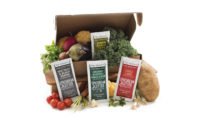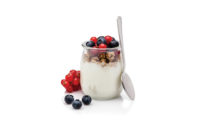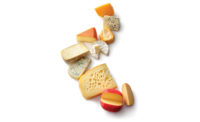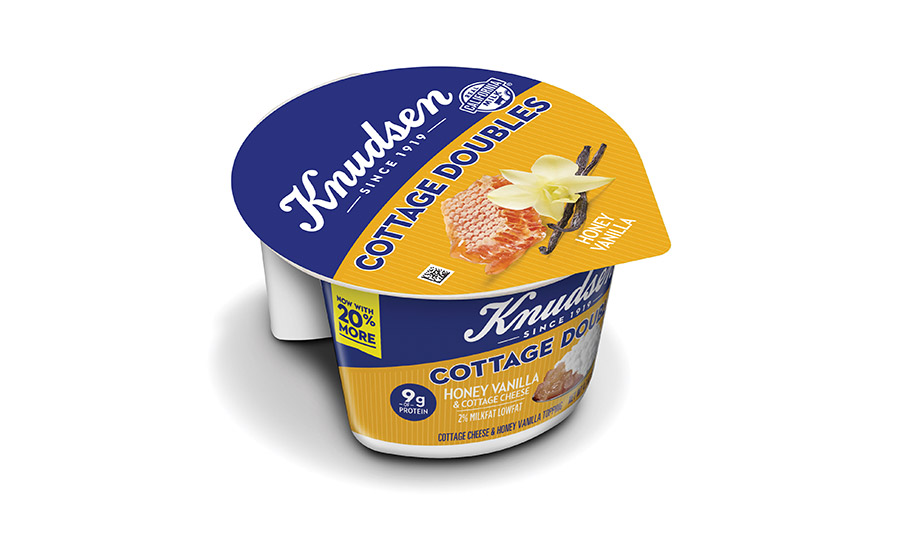2018 State of the Industry report: Cultured dairy aiming for a mealtime, snack-time double play
Consumers give signs for higher protein, more flavors.


























Coming off a sluggish season with near-flat sales across yogurt, sour cream, cream cheese and cottage cheese, cultured dairy products are practicing new techniques in a bid for a World-Series season. The top priority at practice has been positioning the players for new consumption occasions.
Historically, yogurt has claimed the breakfast division title. However, as consumption patterns have shifted toward grab-and-go breakfasts, multiple other convenient food options ranging from muffins to microwaveable breakfast bowls are offering consumers more choices and stealing bases. A leading cultured dairy contender on this convenience front is yogurt drinks.
Milk | Cheese | Cultured | Ice Cream | Butter | Non-dairy Beverages | Ingredients | Exports
Busting the slump
Overall, the U.S. yogurt and yogurt drinks category declined by 4% from 2016 to 2017, but yogurt drink sales are expected to climb 58% by 2022, according to data from global market research firm Mintel. Analysts speculate that yogurt drinks are stealing share from spoonable yogurt, which was down 6.8% from 2016 to 2017, because of the convenience and portability the drinkable subcategory offers.
Among these convenient offerings are the new Dannon Activia Dailies from White Plains, N.Y.-based Danone North America. The low-fat yogurt drinks feature billions of live and active probiotics in a portable 3.1-ounce bottle. Available in five flavors, Activia Dailies are a convenient way for consumers to add good bacteria to their diets and promote their gut health, the company said.
Even more challenging for the food industry is the slide from traditional mealtimes to snack times around the clock.
“According to The NPD Group, only about 14% of consumers are eating just breakfast, lunch and dinner,” said Don Stohrer Jr., head of Arla Foods Inc. USA, Basking Ridge, N.J. “The rest snack between meals and are increasingly eating snacks as a meal. As the line between meals and snacks continues to blend, people are eating anything and everything as a snack.”
This trend is being spearheaded by millennials, who believe that food has to fit into their busy lives, rather than having their lives conform to traditional mealtimes, pointed out Jess Vultaggio, director of marketing for the Philadelphia brand of The Kraft Heinz Co., based in Pittsburgh and Chicago.
This summer, Yoplait, a brand of Minneapolis-based General Mills Inc., extended its popular Oui by Yoplait French-style yogurt brand with Oui by Yoplait Petites. These snack-size yogurts are packaged in 3.5-ounce glass pots and are available in four indulgent flavors — sea salt caramel, chocolate with shavings, dark chocolate raspberry and caramelized apple — to satisfy consumers’ sweet snack time cravings, the company said.
Cream cheese also is leading off in this direction. Philadelphia launched a two-compartment snack pack, Philadelphia bagel chips & cream cheese dips, which pair bagel chips with a variety of flavors of cream cheese. The brand expanded the product lineup this year with the release of Philadelphia pretzel & cream cheese dips, which pair pretzels with either jalapeño-flavored or chocolate-flavored cream cheese.
This fall, the brand also is launching Philadelphia dips as an alternative to homemade dips that busy consumers do not have time to make themselves. Targeted at the pre-dinner and group snacking occasions, the line will feature three flavors — jalapeño cheddar, Southwest style black bean & corn, and Buffalo style with celery — which all can be served hot or cold.
For consumers who bring their own crunchy sides, Arla offers cream cheese in squeeze tubes for easy snacking. The brand has been overwhelmingly successful in its endeavors here. Arla’s sales of soft cream cheese grew 234.8% to $13.9 million in the 52 weeks ending Aug. 12, 2018, according to data from IRI, a Chicago-based market research firm.
And cottage cheese, which used to be revered as a popular healthy snack, is trying to regain that title with a new generation of players.
“We saw there was a perception of cottage cheese as an old-fashioned food,” said Marissa Jarratt, senior vice president of marketing, innovation and R&D for Dean Foods Co., Dallas. “Also, the category itself has suffered from a lack of innovation, something that younger generations are craving in their food decision-making. … We saw an opportunity to reframe the product for today’s consumers.”
In March, Dean Foods released DairyPure Mix-ins as a convenient, better-for-you snack option. The cottage cheese snacks mix DairyPure cottage cheese with fruits and nuts. The line currently is available in strawberry & almond, peach & pecan, blueberry and pineapple varieties, but the brand said it expects to add new flavors next year.
And Chicago- and Pittsburgh-based Kraft Heinz added two varieties to its Breakstone’s and Knudsen Cottage Doubles lines. The products, in mango habanero and honey vanilla flavors, come in a 4.7-ounce dual-compartment container that features cottage cheese on one side and a flavor mix-in on the other.
Cultured dairy as cut-off man
Cultured dairy products also offer significant potential as an ingredient mixed into other foods. Pete Kondrup, general manager of Westby Cooperative Creamery, Westby, Wis., pointed out that there are multiple meal and baked goods recipes that incorporate cottage cheese. And Dallas-based Daisy Brand LLC highlights its cottage cheese as an ingredient in lasagnas, salads and sandwiches in a recent TV commercial.
Although consumers are embracing yogurt as a mealtime side or main course and as a snack, Chobani LLC also is positioning its yogurt as a staple cooking ingredient, similar to how it is used in Europe, the Middle East, Russia and India, explained Niel Sandfort, vice president of product innovation for the Norwich, N.Y.-based company.
“Yogurt is an ancient food that has worked its way into many cuisines around the globe,” he said. “The United States is just a little behind, but we are taking a leadership position to push the yogurt category forward and make it special.”
In August, the company launched Chobani Savor, a squeezable multi-serve offering of low-fat or whole-milk plain Greek yogurt. The packaging shift turns yogurt into a condiment for potatoes, tacos, vegetables, pancakes, crepes and soups, as well as an ingredient for sauces and marinades, Sandfort said.
Along the same lines, New York-based Icelandic Provisions released 24-ounce multi-serve packages of its vanilla and plain skyr for use as cooking ingredients.
“We’re seeing increased use of thick yogurt and skyr in cooking and baking,” said Elliot Shifrin, vice president of marketing. “Just look at your Instagram feed to see how millions of Americans are cooking and assembling beautiful bowls of food with yogurt and skyr.”
Lifeway Foods Inc., Morton Grove, Ill., also is trying to position its kefir as a key ingredient. In March, the company released The Kefir Cookbook, which features more than 100 globally inspired recipes that include kefir. Julie Smolyanski, Lifeway Foods’ CEO and author of the cookbook, details how consumers can use kefir to make healthier and more nutritious versions of huevos rancheros, butternut squash and pumpkin soup, grilled lamb chops with kefir Verde sauce, panna cotta, scones and more.
Kefir as a category has been suffering, however, with refrigerated kefir sales down 16.3% in the year ending Aug. 12, 2018, the IRI data show. Sales of Lifeway Foods’ refrigerated kefir dropped more than 17% in the same period.
As for sour cream, it’s most commonly consumed as an ingredient within another food or as a topping. Daisy Brand has been pitching to this market during the past few years through its sour cream in squeezable pouches. This packaging innovation enables consumers to squeeze a dollop of sour cream on top of a baked potato, a taco or another food.
According to London-based TechNavio, North American consumers ate 174 million pounds of sour cream last year. Although IRI tracked only 0.5% growth for U.S. sour cream sales in the year ending Aug. 12, 2018, TechNavio predicts that this segment will experience a compound annual growth rate of 2.2% between 2018 and 2023, thanks to growing demand for functional cultured dairy products. In particular, consumer interest is growing because of sour cream’s beneficial gut-health bacteria.
Healthy bases loaded
Speaking of health, consumers expect many of their cultured dairy product snacks to be a better-for-you grand slam. And parents often are concerned about the quality of the foods they are feeding their children. As a result, children’s yogurt is the largest subcategory within organic yogurt that is showing growth, noted Alex Shams, associate brand manager for Organic Valley, La Farge, Wis.
When the company noticed there was not a 100% grass-fed option within the subcategory, it launched one: Organic Valley grassmilk kids yogurt. The yogurt contains milk produced by cows that are 100% grass-fed. The Journal of Food Science and Nutrition reported earlier this year that cows on such a diet produce milk with much more omega-3 fatty acids and conjugated linoleic acid than conventional milk.
“With Organic Valley grassmilk kids yogurt, parents can get peace of mind knowing they’re giving their kids the highest quality yogurt, one that maximizes nutrition for their development and growth,” Sham said.
And a couple of brands are packing on the protein. For example, the new plain YQ by Yoplait variety offers 17 grams of protein and only 1 gram of sugar in each 5.3-ounce serving. The line’s flavored varieties, which include coconut, peach, mango, lime, strawberry and blueberry, contain 9 grams of sugar — which is 40% less than the leading Greek low-fat yogurt — and 15 grams of protein per serving.
For its part, Ehrmann Commonwealth Dairy, Brattleboro, Vt., kicked off the year by launching its own line of Vermont-style skyr with higher protein per ounce and less sugar. And in the cream cheese category, Arla joined the protein game with the release of Arla cream cheese skyr, a blend of cream cheese and Icelandic-style yogurt that is naturally higher in protein and lower in sugar and fat, the company said.
New York City-based Siggi’s Dairy, which has been offering low-sugar, high-protein Greek yogurts for years, is branching out into the healthy fat and healthy mix-in leagues. Heidi Krauss, vice president of marketing and business development, said the company is seeing a shift toward whole-milk and higher-fat products, which denotes consumers’ interest in less-processed, more wholesome foods. The new Siggi’s Simple Sides combine Icelandic whole-milk skyr in a variety of flavors with no-sugar-added toppings such as dried fruit, nuts and coconut. The products contain, on average, 15 grams of protein and 11 grams of sugar per 5.3-ounce serving.
Other brands also are focusing on striking out sugar. Late this summer, Chobani rolled out its Hint Of offering nationwide. The new yogurt line is made with 2% milk and natural sweeteners, which results in a product that contains half the sugar of other yogurts, Sandfort said. Chobani Hint Of is available in the “slightly sweet” flavors of Madagascar vanilla cinnamon, wild blueberry, Monterey strawberry, Gili cherry and Alphonso mango.
And makers of cottage cheese, which naturally is high in protein and low in sugar, are repositioning the cultured dairy product as a desirable, interesting snack that boasts an impressive health batting average. The new black cherry, vanilla and raspberry fruit-on-the-bottom cottage cheese products from Princeton, N.J.-based Muuna Inc. also are enriched with the probiotic Bifidobacterium lactis, which supports digestive health. In addition, the cottage cheese snacks provide calcium, potassium and vitamins A and C.
Muuna surveyed consumers’ flavor interests and before launching the flavor varieties, which were inspired by yogurt flavors, CEO Gerard Meyer pointed out. And this fall, Muuna is bringing another popular flavor from other food and beverage categories into the cottage cheese market: pumpkin. The brand will release limited-edition pumpkin & spice to participate in this seasonal trend.
Looking ahead, enticing flavors will be a key differentiator among healthy cultured dairy products. Although consumers want health benefits, they do not want to sacrifice on taste. Mintel reported that indulgent and fruit flavors will drive trial among new brands and product styles and encourage consumers to explore new consumption opportunities. However, the market research firm cautions that cultured dairy makers should not pitch too much variety into the category, or consumers will be overwhelmed with options and reach for a familiar brand or flavor instead of trying all that the category has to offer.
Milk | Cheese | Cultured | Ice Cream | Butter | Non-dairy Beverages | Ingredients | Exports
Looking for a reprint of this article?
From high-res PDFs to custom plaques, order your copy today!


















